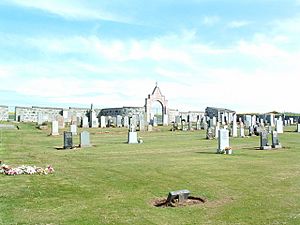George Chrystal facts for kids
Quick facts for kids
George Chrystal
FRSE FRS
|
|
|---|---|

George Chrystal (1851–1911)
|
|
| Born | 8 March 1851 |
| Died | 3 November 1911 (aged 60) |
| Resting place | Foveran Churchyard, Aberdeenshire |
| Nationality | Scottish, UK |
| Alma mater | University of Aberdeen Peterhouse, Cambridge |
| Known for | Experimental verification of Ohm's law Chrystal's equation |
| Spouse(s) | Margaret Anne Balfour (1870-1903 her death) |
| Awards | Royal Medal (1911) |
| Scientific career | |
| Fields | Physicist and mathematician |
| Institutions | University of St Andrews University of Cambridge University of Edinburgh |
| Academic advisors | James Clerk Maxwell |
| Notable students | Joseph Wedderburn |
George Chrystal (born March 8, 1851 – died November 3, 1911) was a brilliant Scottish mathematician. He is famous for his books on algebra, which is a type of math that uses letters and symbols.
He also studied "seiches," which are like sloshing waves in big lakes or other enclosed bodies of water. His important work on seiches earned him a special award called the Gold Medal from the Royal Society of London.
Early Life and Education
George Chrystal was born in Old Meldrum, Scotland, on March 8, 1851. His father, William Chrystal, was a successful farmer and grain merchant.
He went to school at Aberdeen Grammar School. Later, he studied at the University of Aberdeen. In 1872, he moved to Cambridge to learn from the famous scientist James Clerk Maxwell.
George Chrystal graduated from Cambridge in 1875. He was named "Second Wrangler," which means he was the second-best math student in his year. After graduating, he became a fellow at Corpus Christi College.
A Career in Mathematics
In 1877, George Chrystal became a professor of mathematics at the University of St Andrews. Just two years later, in 1879, he moved to the University of Edinburgh to take on the same role.
He was a very active and important person in the world of mathematics.
- He helped create the Edinburgh Mathematical Society. This group helps mathematicians share ideas and learn from each other.
- He was elected a Fellow of the Royal Society of Edinburgh in 1880. This is a big honor for scientists and thinkers in Scotland.
- He won several awards from the Royal Society of Edinburgh for his research.
In 1911, he received the Royal Medal from the Royal Society. This award was for his studies of the waves and movements of water in Scottish lochs (lakes).
Later Years and Legacy
George Chrystal lived in Edinburgh at 5 Belgrave Crescent. He became ill in 1909, and his health worsened in 1911. He passed away on November 3, 1911, in Edinburgh. He is buried in Foveran Churchyard in Aberdeenshire.
His work in algebra and his studies of water movements in lakes continue to be important in mathematics and physics.
Family Life
George Chrystal married Margaret Anne Balfour in 1879. They had four sons and two daughters. Sadly, Margaret passed away in 1903, before George. Their son, Walter MacDonald Chrystal, also died when he was very young.




